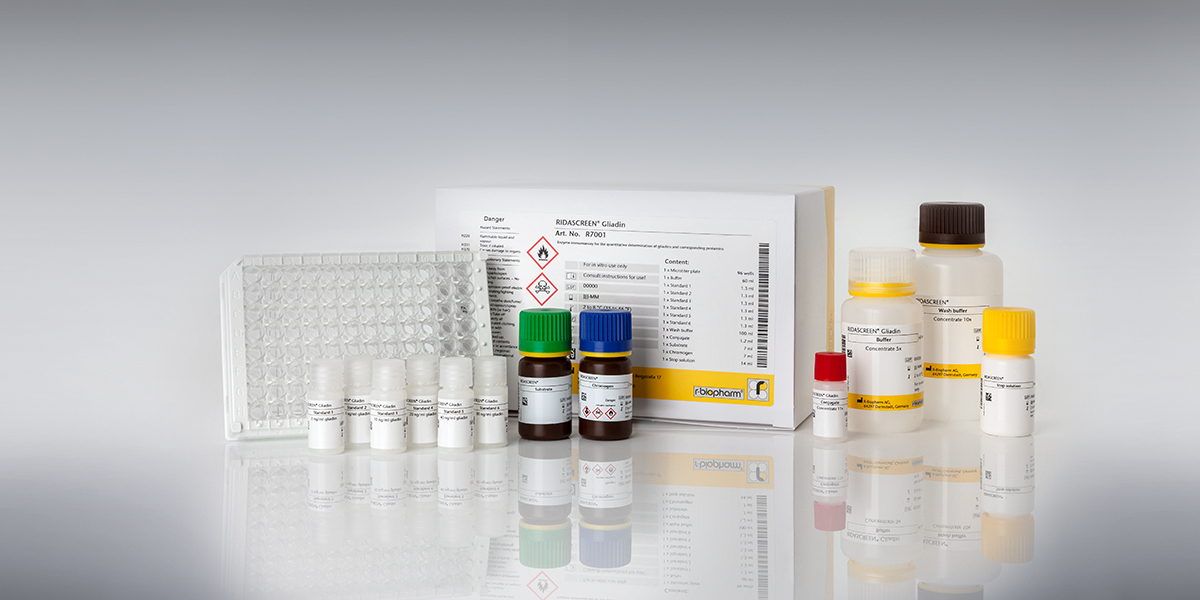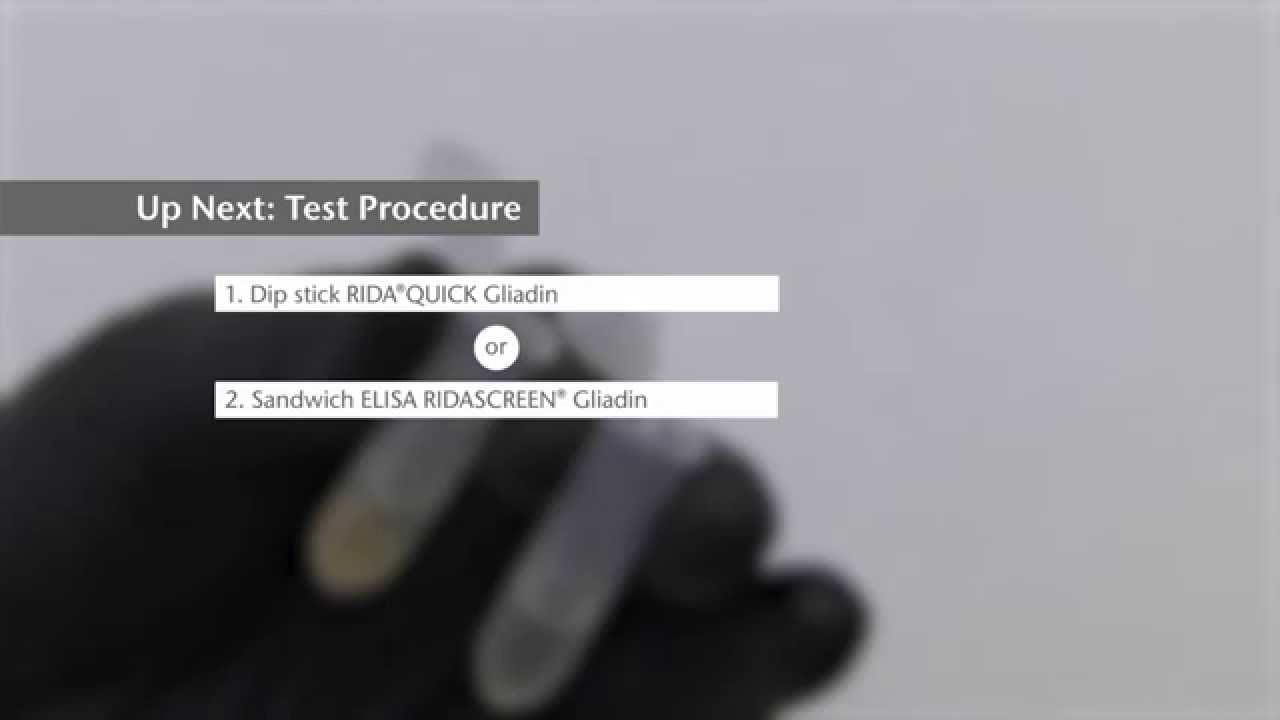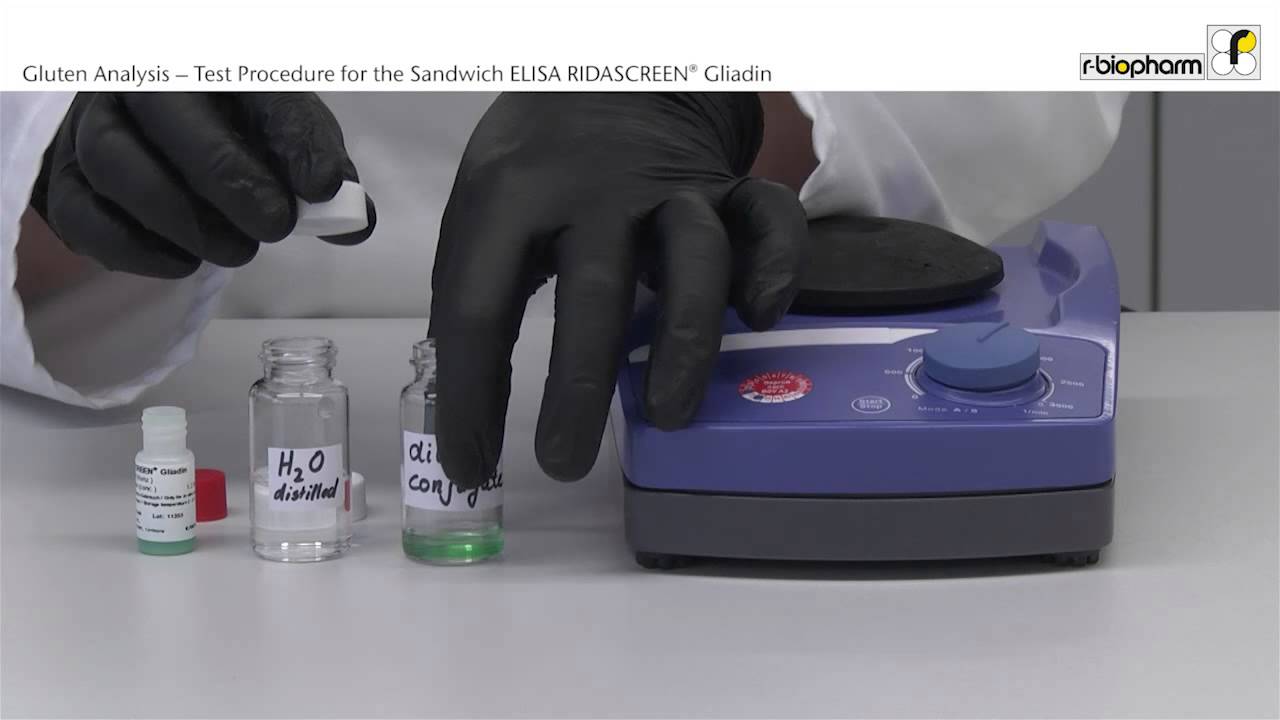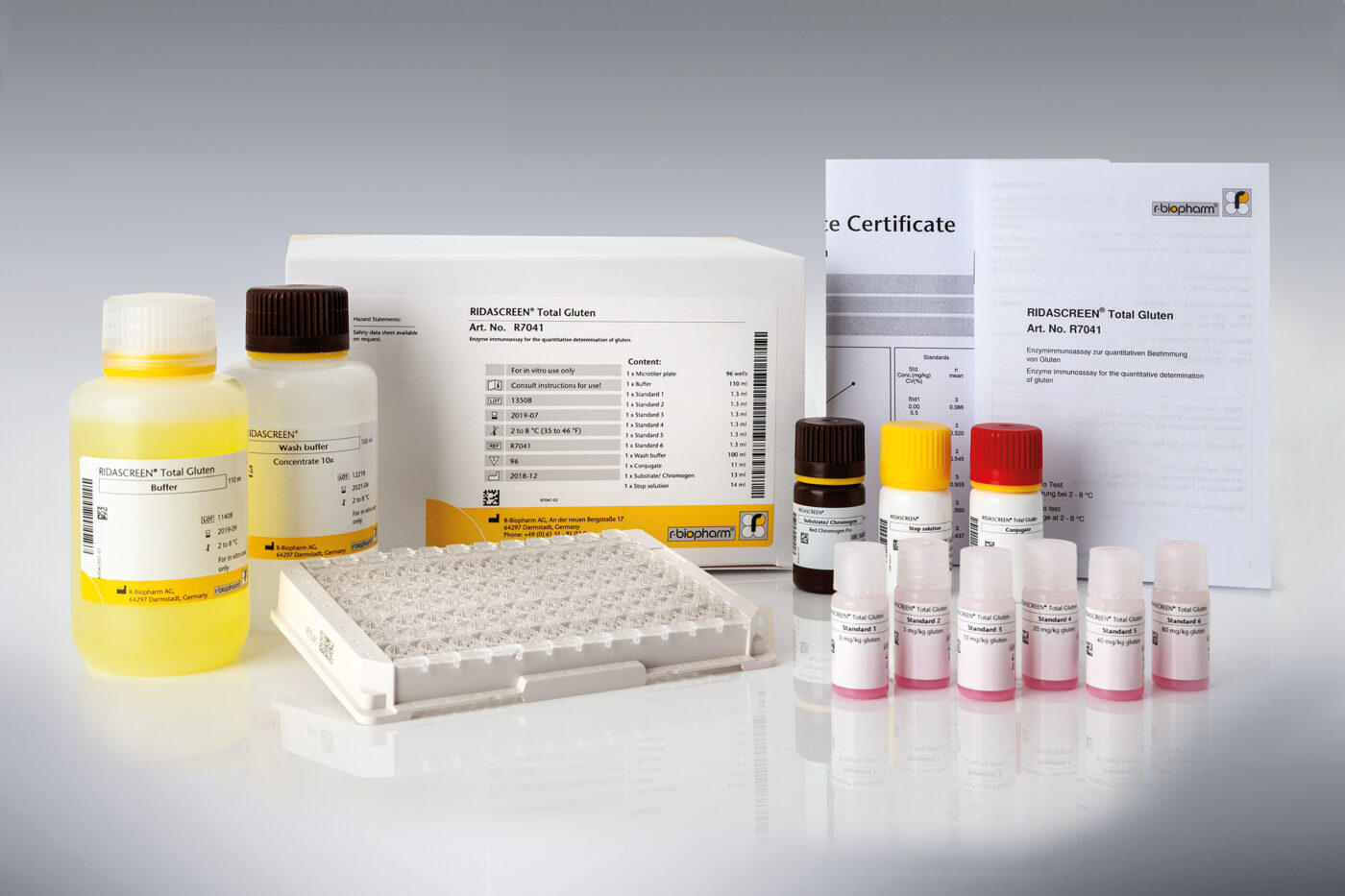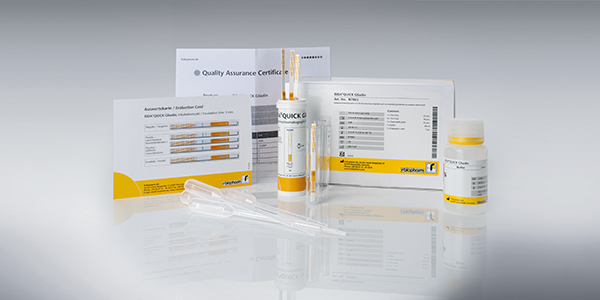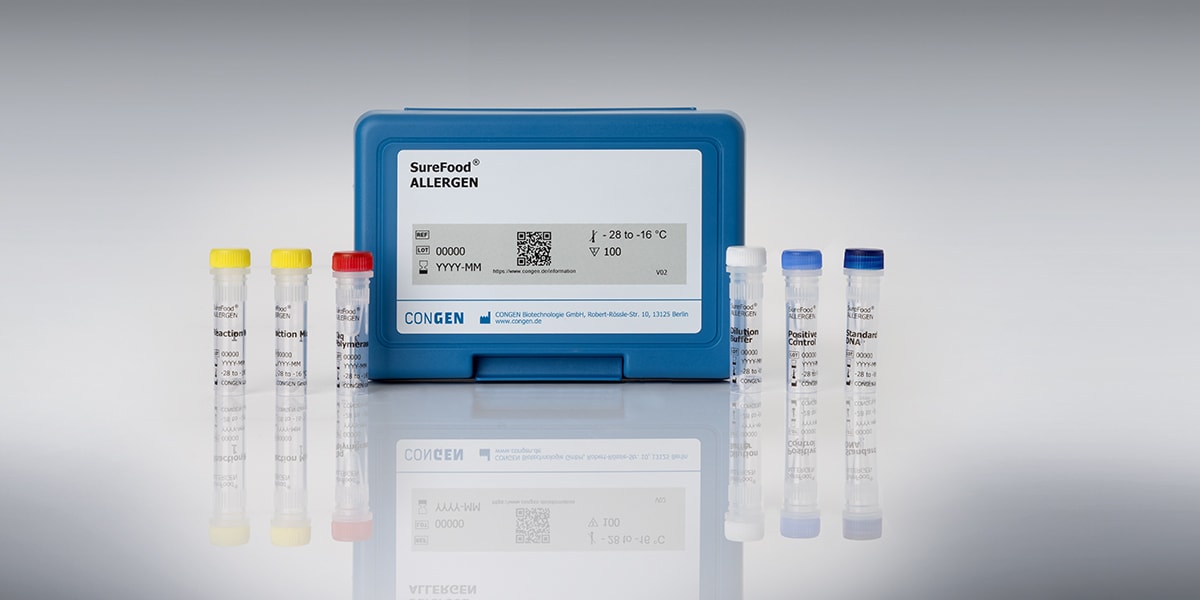
RIDASCREEN® Gliadin
Art. No. R7001
Product info about RIDASCREEN® Gliadin
Intended use
Reference ELISA test method for gluten detection!
Ensure safe quantitative analysis of prolamins from wheat (gliadin), rye (secalin) and barley (hordein) in food with the reference method. The RIDASCREEN® Gliadin in combination with the Cocktail (patented) is Codex Alimentarius type I method (CODEX STAN 234-1999) and AOAC Official Method of Analysis (AOAC-OMA 2012.01).
RIDASCREEN®Gliadin is an R5-based sandwich enzyme immunoassay for the quantitative analysis of contaminations of intact gliadin as a measure of gluten from wheat, rye and barley in unprocessed and processed matrices from important gluten-free food categories. The used specific monoclonal antibody (R5) detects the amino acid sequences in the prolamin fraction of gluten that are toxic to coeliac disease patients. However, it does not react with epitopes of prolamins (avenin) from oats which are tolerable for most celiac patients. Hence, it can be used to detect wheat, rye and barley gluten in oat products for gluten-free labelling purposes.
The Méndez method – a combination of R5 ELISA and a special, patented buffer (cocktail) for optimized extraction of gliadin from heat-processed and non-heated food samples – is the Codex Alimentarius recommended method for analysis of gluten in food. The Méndez method is Codex Alimentarius type I method for analysis of gliadin/gluten. Categorization as type I method defines it as reference method. R-Biopharm is the only R5 ELISA manufacturer who offers the licensed Cocktail (patented) (Art. No. R7006 / R7016) and hence fulfills the requirements of the reference method to 100 %.
Applicability for analysis of principally all foods is an important requirement to function as Méndez method in the meaning of Codex Alimentarius. The publication of the 3rd international collaborative proficiency study from 2020 describes the preparation of 900 samples of 19 differently processed foods from 16 food categories and the obtained results demonstrating it suitability for gluten detection in gluten-free foods. Accordingly, RIDASCREEN® Gliadin received from the AOAC as first assay worldwide the status as Official Method of Analysis (AOAC OMA 2012.01) “in food” in 2021. A limitation on certain validated food matrices as usual for other AOAC approvals is not present any longer.
Further international certificates/approvals are:
- AOAC-RI – PTM certification no. 120601
- AACCI – Approved Method 38-50.01
- ICC Standard Method no. 182
Benefits:
- Reference method: Codex Alimentarius Type I Method (Méndez Method: R5 ELISA + Méndez-Cocktail); only R-Biopharm offers Méndez-Cocktail
- Best independently validated test kit: Only test approved as AOAC-OMA Final Action (2012.01)
- Test kit with most collaborative studies done. View more
General Information
The use of gluten in foodstuffs is extremely common because of its useful effects on e.g. texture, moisture retention and flavor. However, gluten intolerance disorders like coeliac disease require a permanent gluten-free diet to avoid clinical symptoms. According to the Codex Alimentarius (CODEX STAN 118-1979) foods for special dietary use for persons intolerant to gluten may contain up to 20 mg/kg gluten to be tolerated by celiac patients. Foods containing < 20 mg/kg gluten can be labelled “gluten-free”.
The threshold of 20 mg/kg has been adopted by national legislations in many countries. Gluten of wheat, rye and barley is a mixture of prolamin and glutelin proteins. Prolamins from wheat are named gliadins. The prolamine content of wheat gluten is defined as 50 % (CODEX STAN 118-1979). R5-based ELISA methods, which have been calibrated against gliadin (prolamin part of wheat gluten), therefore need to be multiplied by factor of 2 to calculate the gluten concentration.
You can find further information on the scientific background of the test system in the following documents:
- Levels of gliadin in commercial beers (Lindsay J. Guerdrum, Charles W. Bamforth) published in Food Chemistry (2011)
- A comparison of gluten levels in labeled gluten-free and certified gluten-free foods sold in the United States (T. Thompson, S. Simpson) published in European Journal of Clinical Nutrition (2014)
Following extraction solutions are validated for this method:
- Cocktail (patented) (Art. No. R7006 / R7016)
Additional extraction solutions are:
- RIDA® Extraction Solution (colorless) (Art. No. 7098)
- RIDA® Cocktail ECO (Art. No. R7080) *
- 60 % ethanol
* Patent Marking:
If the R-Biopharm product “Cocktail ECO” is used for the processing of food samples, a sulphite-containing extraction agent is used. Food inspection methods using a sulfite-containing extractant as in this product and/or corresponding detection kits are subject to the following patents of MORINAGA & Co., Ltd.: European Patent EP 2 224 239 B1, Australian Patent AU 2008 330 507 B2, United States Patent US 8 859 212 B2, Japanese Patent JP 5 451 854 B2. The patent holder has granted R-Biopharm AG a license to use, and sell products that employ, said protected technology in the above-mentioned territories.
Accessories
- Cocktail (patented)
- Cocktail ECO
- RIDA® Extraction Solution (colorless)
- Set of 3 processed Gliadin Assay Controls
Videos
Dear customers,
we provide the documents for our products in an electronic format which include the Instructions for Use (IFU), the Safety Data Sheets (SDS) and the Certificate of Analysis (CoA). For batches placed on the market after 01. January 2024, you can find our documents on the eIFU portal eifu.r-biopharm.com/food.
| Specifications | |
|---|---|
| Art. No | R7001 |
| Test format | Microtiter plate with 96 wells (12 strips with 8 removable wells each) |
| Sample preparation | Homogenization and extraction |
| Incubation time | 1 h 30 min Room temperature |
| LOD (Detection Limit) | 0.5 mg / kg (ppm) Gliadin (mean) or 1 mg / kg (ppm) Gluten 0.06 - 1.24 mg / kg (ppm) Gliadin* (*depending on matrix) |
| LOQ (Limit of quantification | 2.5 mg / kg (ppm) Gliadin or 5 mg / kg (ppm) Gluten |
| Validated matrices | Rice- and corn-based products, soy, starches, pseudo cereals, legumes, spices, juice, nut nougat crème, cream cheese, pesto, meat, vegetarian meat alternative, cookies, dessert, cake, fish, bread, candies, and potatoes |
| Detected analyte | • The main epitope of the R5 antibody is the amino acid sequence QQPFP which is part of many celiac-toxic sequences. |
| Available application notes |
|
| Evaluation | Microtiter plate spectrophotometer (450 nm) |
| Approvals | • AOAC-OMA 2012.01 "Final Action" ("in foods" claim) • AOAC-RI (120601) • ACCI 38.50.01 • Codex Alimentarius Methode (Typ I) • ICC |

